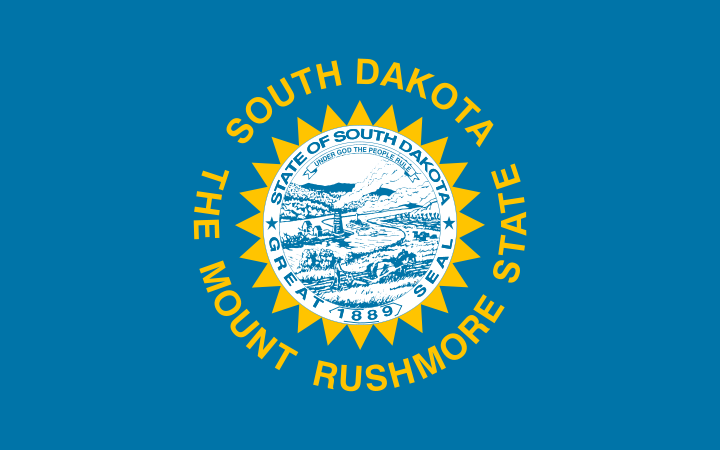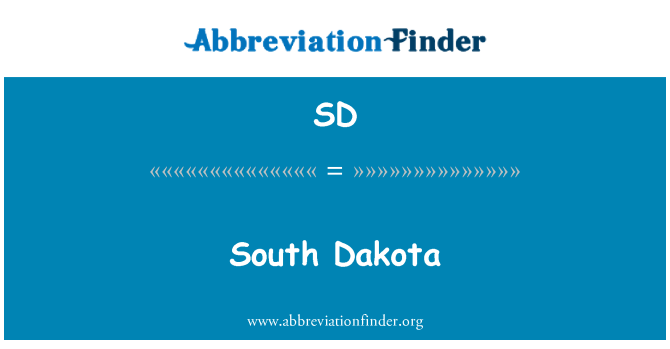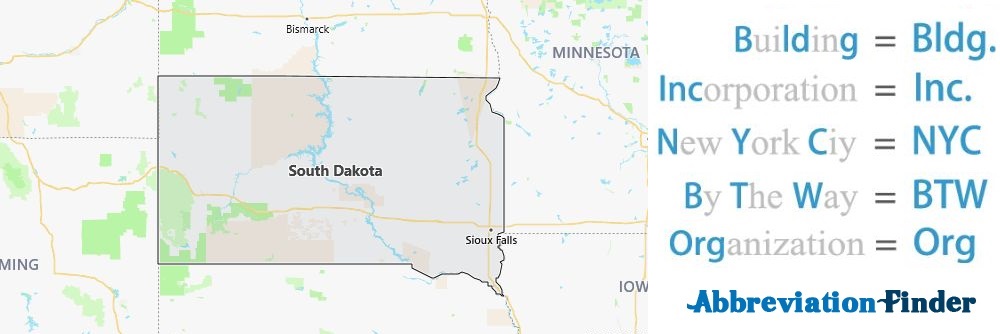What is the abbreviation for South Dakota state?
SD is the 2 letter abbreviation for South Dakota, the 46th largest state in the United States of America. South Dakota is a state located in West North Central part of U.S.A, bordering Iowa, Minnesota, Montana, Nebraska, North Dakota, and Wyoming. Pierre is the capital city of South Dakota. Major cities include Sioux Falls (Population: 171555), Rapid City (Population: 73580), Aberdeen (Population: 28113), Brookings (Population: 23668), Watertown (Population: 22084), Mitchell (Population: 15680), Yankton (Population: 14568), Pierre (Population: 14013), Huron (Population: 13324), Spearfish (Population: 11294), Vermillion (Population: 10749), and Brandon (Population: 9867).

South Dakota State Profile
- Capital: Pierre
- Admitted to USA: 1889
- Area: 199,729 km2
- Population: 884,659
- Time zone: GMT-6, GMT-7
- Calling code: 605
- ISO 2-Letter Postal Abbreviation: SD
- State Government Website: http://www.sd.gov/
Overview
South Dakota is located in the Midwestern United States. With about 825,000 inhabitants, the state is sparsely populated. The area was incorporated into the Union on November 2, 1889, as the 40th state. The state is one of the so-called prairie states and its nickname is “The Mount Rushmore State”. By the way, the motto of South Dakota is “Under God, the people rule”. South Dakota borders North Dakota to the north, Minnesota and Iowa to the east, Nebraska to the south, and Wyoming and Montana to the west.
The state covers an area of 199,905 km², making it 17th place in all US states. The capital, Pierre, is in the center of the state and has approximately 14,000 residents. The largest city, however, is Sioux Falls in the southeast, the most populous part of the state, with approximately 155,000 inhabitants. The state is named after the Lakota and Dakota tribes of the Sioux Indians, who had one of their settlement areas here. It is therefore not surprising that there are still many Indian reservations in South Dakota. The state of South Dakota can therefore be described as an “immigrant state” and if you look at the ancestors of today’s residents, it is striking that Germans (40%), Norwegians (15%) and Irish (10%) settled here. This can still be seen today in some local festivities, such as the taste festival.
Geographically, South Dakota can be divided into east and west, as the Missouri River divides the state, with the western part being characterized by the Black Hills mountain range and the eastern part by a rather flat landscape. The eastern part of South Dakota is also located in the so-called Tornado Alley. This is a particularly tornado-rich area in the Midwestern United States, where over a thousand large and small tornadoes roam across the country each year, especially in the spring. The US states of Oklahoma, Arkansas and Missouri are entirely within Tornado Alley. The northeastern part of Texas and the north of Louisiana also count, the northwestern part of Mississippi, central and southern Illinois, the southwestern Indiana and parts of Nebraska, and smaller parts of Tennessee and Kentucky to Tornado Alley. South Dakota’s economy is largely agricultural. In the eastern part, due to the fertile soil, mainly grain farming is carried out, ranches find cattle farming to the west. Mining is important in the mountainous regions of the western part of the state, especially the search for gold is still a driving force.
South Dakota’s main tourist attractions are certainly the Mount Rushmore National Memorial with the heads of four American Presidents, the Wind Cave National Park and the Badlands National Park.
Cities and larger towns
With its approximately 14,000 inhabitants, Pierre Pierre is the capital of the state of South Dakota. Pierre is centrally located in South Dakota on the Missouri River and was founded in 1880 and designated the capital of South Dakota in 1889. In addition to the impressive State Capitol, the Cultural Heritage Center and the nearby Lake Oahe, Pierre is a great starting point for a tour of the Native American Scenic Byway.
Aberdeen
Aberdeen is the state’s third largest city and has approximately 26,000 residents. Aberdeen is located in the northeast of South Dakota and was founded in 1882. The city is the seat of Northern State University, which is particularly interesting for visitors because of its galleries. The nearby Richmond Lake Recreation Area is also interesting for tourists, as it invites you to go camping, fishing and hiking.
Brookings
The city of Brookings in eastern South Dakota has approximately 22,000 residents, making it the fourth largest city in the state. Brookings is home to South Dakota State University, the state’s largest university. Most of the city’s population has ancestors from Germany and Norway.
Custer
Custer in southwestern South Dakota is relatively small with only about 2,000 inhabitants, but is still the oldest city in the Black Hills. Custer is particularly interesting for tourists because of its location. Mount Rushmore, the Wind Cave National Park and the Jewel Cave National Monument are close to the city.
Deadwood
Deadwood in western South Dakota was founded in 1876 during the gold rush and is named after the dead trees in the adjacent gorge. The former gold mining town in the Black Hills has only about 1,200 inhabitants, but it is one of the most legendary towns in the gold mining era and western expansion in the USA. The city stands out with the surrounding scenic beauty. Deadwood offers excellent opportunities for hiking, cycling and horse riding in summer. Deadwood also has the northern end of the George S. Mickelson Trail.
Mitchell
has approximately 15,000 residents and is located in the southeastern part of the state. The city was founded in 1883. Mitchell or the surrounding landscape shows the prairie at its most beautiful with its light hilly landscape. The city’s main attraction is the Corn Palace, which is also fondly described as the “Taj Mahal of Agriculture”.
Rapid City
With approximately 70,000 residents, Rapid City is the state’s second largest city and is located at the foot of the Black Hills in western South Dakota. The city was founded in 1882 in connection with the gold rush of the Custer expedition. The city is rich in smaller attractions. In Rapid City, for example, you can find a piece of the Berlin Wall, a dinosaur park and 43 life-size bronze statues of all previous US presidents. Rapid City is also an excellent base for trips to Mount Rushmore National Memorial, Crazy Horse Memorial and the Black Hills National Forest.
Sioux Falls
With around 150,000 residents, Sioux Falls is by far the largest city in the state of South Dakota. Sioux Falls is located in the southeast of the state on the Big Sioux River and is named after the waterfalls there. The city was founded in 1856. In recent years the city has developed from a rather sleepy town to a tourist-interesting town and is considered by locals to be the most important urban center of the Great Plains between Minneapolis and Denver. Due to its size, Sioux Falls offers museums, galleries, malls and all kinds of entertainment options for its visitors. The historic buildings in the city center around Falls Park are also worth seeing. The Palisades State Park is located northeast of Sioux Falls.
List of South Dakota Acronyms
The most commonly used abbreviations about South Dakota are SD which stands for South Dakota. In the following table, you can see all acronyms related to South Dakota, including abbreviations for airport, city, school, port, government, and etc.

View this article in other languages:
Deutsch – Français – 繁體中文


